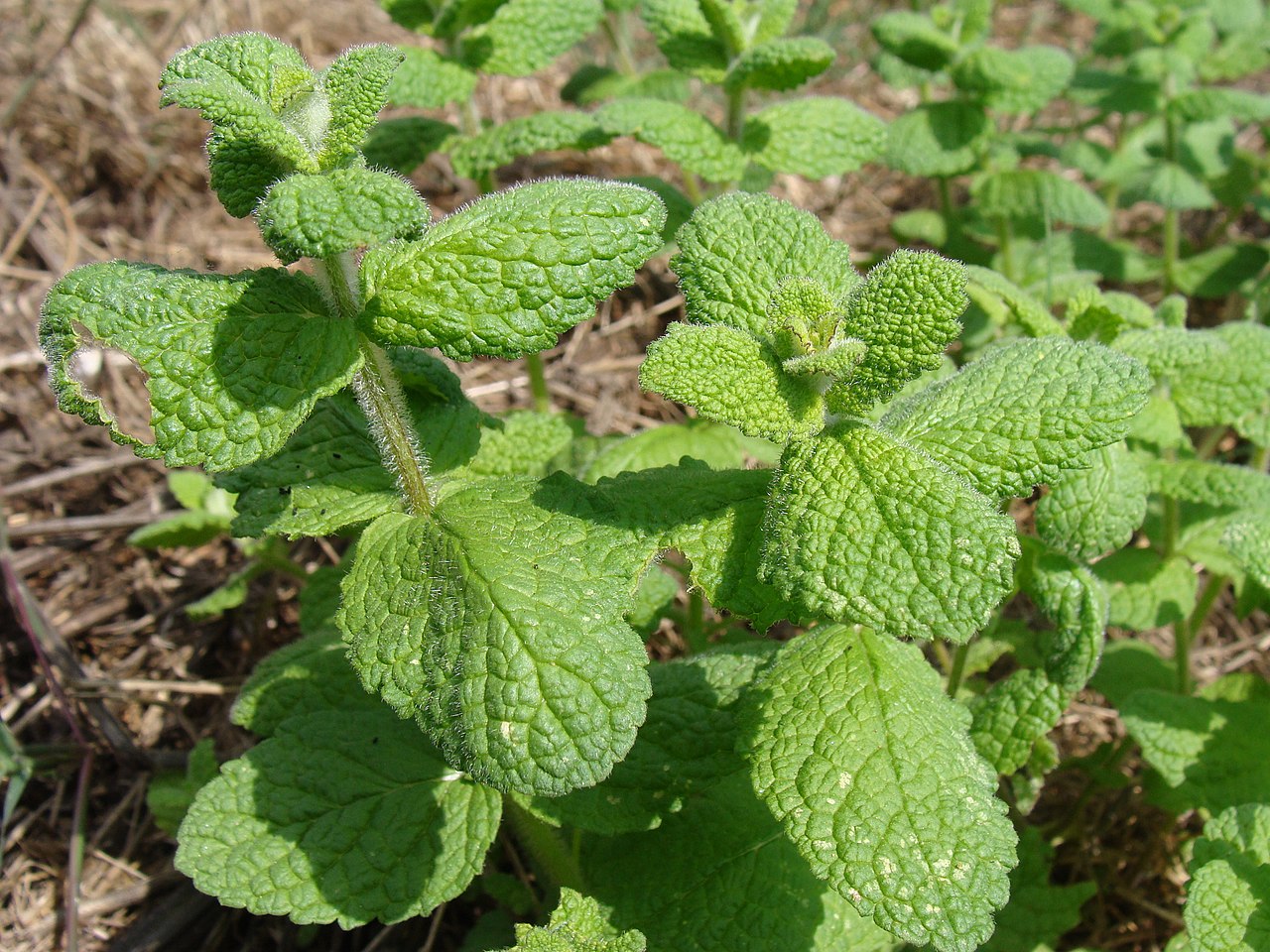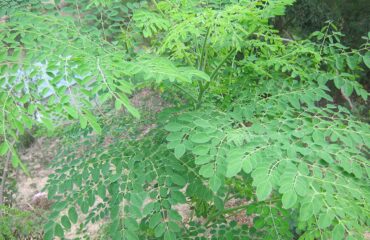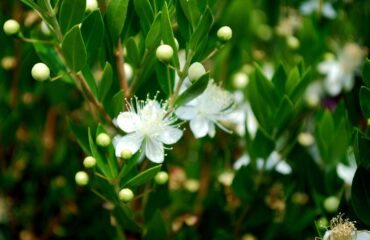Mentha, commonly known as Mint, is a diverse genus of aromatic, perennial herbs in the Lamiaceae family. Native to Europe, Africa, and Asia, Mint species are renowned for their fragrant leaves, which are often used in culinary applications, teas, and traditional medicine. The plants have square stems, paired opposite leaves, and produce small flowers in shades of white, pink, or purple. Mint plants are highly vigorous and can spread rapidly through their creeping rhizomes. Popular species and hybrids include Mentha spicata (Spearmint), Mentha piperita (Peppermint), Mentha suaveolens (Apple Mint), and Mentha × piperita citrata (Eau de Cologne Mint). Mint plants typically grow to a height of 12-36 inches (30-90 cm) and spread indefinitely if not controlled, making them excellent for garden beds, containers, and herb gardens.
Preferred Growing Conditions:
- Soil Type: Prefers well-drained, moist, and fertile soil; thrives in a mix of loamy soil enriched with compost or organic matter. Mint can tolerate a range of soil types but prefers slightly acidic to neutral pH.
- Sunlight: Grows best in full sun to partial shade; requires at least 4-6 hours of direct sunlight daily for optimal growth. In hotter climates, some afternoon shade can be beneficial.
- Temperature: Hardy in USDA zones 3-9 depending on the species; tolerates cold winters and warm summers. Mint can adapt to various climates but prefers temperate conditions.
- Water Needs: Moderate to high; requires regular watering to keep the soil consistently moist but not waterlogged. Mint thrives in consistently damp conditions but can suffer in drought.
Mentha (Mint) Propagation Methods:
1. Stem Cuttings:
Stem cuttings are the most common and effective method for propagating Mentha, allowing for the production of new plants that retain the characteristics of the parent.
- Types of Cuttings:
- Use softwood cuttings taken in late spring to early summer when the plant is actively growing.
- Preparation:
- Select healthy, non-flowering shoots and cut 3-6 inch sections just below a leaf node.
- Remove the lower leaves, leaving only the top few pairs of leaves on the cutting.
- Optionally, dip the cut end in rooting hormone to encourage faster rooting.
- Rooting in Water:
- Place the cuttings in a container of water, ensuring the cut ends are submerged.
- Place the container in a bright, indirect light location.
- Change the water every few days to keep it fresh and clear.
- Roots should begin to form within 1-2 weeks.
- Rooting in Soil:
- Alternatively, insert the cuttings directly into a well-draining potting mix, such as a blend of peat and perlite.
- Water lightly to settle the soil and place the pot in a bright, indirect light location.
- Cover the pot with a plastic bag or place in a propagation tray with a clear lid to maintain high humidity.
- Transplanting:
- Once roots are well-established and new growth appears, transplant the rooted cuttings into individual pots or directly into the garden.
- Gradually acclimate the new plants to outdoor conditions if they were started indoors.
2. Division:
Division is a straightforward and effective method for propagating Mentha, particularly for mature, well-established clumps. This method helps rejuvenate the parent plant and produce new plants with identical characteristics.
- Timing:
- The best time for division is in early spring before new growth begins or in early autumn after the active growing season.
- Method:
- Carefully dig up the clump from the garden or remove the plant from its pot, taking care not to damage the roots.
- Use a sharp knife or garden spade to divide the root ball into smaller sections, ensuring each division has several shoots and a portion of the root system.
- Remove any dead or damaged roots and foliage.
- Replanting:
- Replant the divisions immediately in prepared pots filled with a well-draining potting mix or directly into the garden.
- Plant at the same depth as the original clump, spacing divisions to allow room for growth.
- Water thoroughly to settle the soil around the roots.
- Care After Division:
- Keep the newly planted divisions well-watered as they establish.
- Place the pots in a bright, indirect light location or a partially shaded spot in the garden.
- Protect from strong drafts and sudden temperature changes during the initial recovery period to prevent stress.
3. Layering:
Layering can be used to propagate Mentha, particularly for stems that can be encouraged to root while still attached to the parent plant.
- Timing:
- Best done in spring or early summer when the plant is actively growing.
- Method:
- Select a healthy, flexible stem near the base of the plant.
- Bend the stem down to the ground and make a shallow cut or wound on the underside where it will be buried.
- Apply rooting hormone to the wound to encourage rooting.
- Bury the wounded section of the stem in the soil, securing it with a U-shaped pin or a rock.
- Keep the soil moist and leave the stem in place for several weeks to allow roots to develop.
- Rooting and Separation:
- Once a good root system has developed, cut the stem from the parent plant and carefully remove the rooted section.
- Plant the rooted section in a pot or directly in the garden, ensuring the roots are well-covered and watered thoroughly.
4. Root Cuttings:
Root cuttings are an alternative propagation method for Mentha, particularly useful when you want to propagate from the existing root system.
- Timing:
- The best time for root cuttings is in late winter to early spring before new growth begins.
- Method:
- Carefully dig around the base of the parent plant to expose a portion of the root system.
- Select healthy roots and cut 2-4 inch sections, ensuring each section has several small feeder roots.
- Treat the cut ends with rooting hormone to encourage faster rooting.
- Planting:
- Plant the root cuttings horizontally or vertically in a well-draining potting mix, such as a blend of peat and perlite.
- Water lightly to settle the soil and place the pots in a bright, indirect light location.
- Maintain high humidity by covering the pots with plastic bags or placing them in a propagation tray with a clear lid.
- Rooting and Growth:
- Roots should begin to establish within a few weeks.
- Once the cuttings are well-rooted and begin to grow, gradually acclimate them to normal indoor or outdoor conditions.
- Transplant the well-rooted cuttings into larger pots or their permanent locations.
Care for Newly Propagated Plants:
- Place new plants in a location with full sun to partial shade to encourage vigorous growth and aromatic foliage.
- Water regularly to keep the soil consistently moist but not waterlogged.
- Feed with a balanced, water-soluble fertilizer every 4-6 weeks during the growing season to promote healthy growth and strong aroma.
- Protect from strong winds and sudden temperature changes to prevent stress.
- Use pots with drainage holes to prevent water accumulation and root rot when growing Mint in containers.
Common Challenges and Solutions:
- Invasive Growth: Mint can be highly invasive in the garden. To control its spread, grow it in containers or use root barriers to confine it.
- Powdery Mildew: Ensure good air circulation around plants and avoid overhead watering. Treat with fungicides if necessary.
- Aphids and Spider Mites: Monitor for common pests and treat infestations with insecticidal soap or neem oil.
Additional Tips:
- Prune regularly to maintain the desired shape and size and to encourage dense, bushy growth.
- Rotate pots regularly to ensure even light exposure and prevent the plant from leaning towards the light.
- Mint is excellent for culinary uses, teas, and aromatherapy due to its fresh, invigorating aroma and flavor.
- Harvest leaves regularly by pinching them off just above a leaf node to encourage more branching and foliage growth.
- Mint plants are excellent for adding fragrance and flavor to herb gardens, borders, and containers due to their rapid growth and aromatic foliage.
Conclusion:
Propagating Mentha provides a rewarding opportunity to grow these aromatic and versatile herbs in your garden or home. Whether you choose to start from stem cuttings, use division, layer stems, or plant root cuttings, with proper care and attention, Mint will thrive and bring its fresh, invigorating fragrance and flavor to your space.
Share this article


